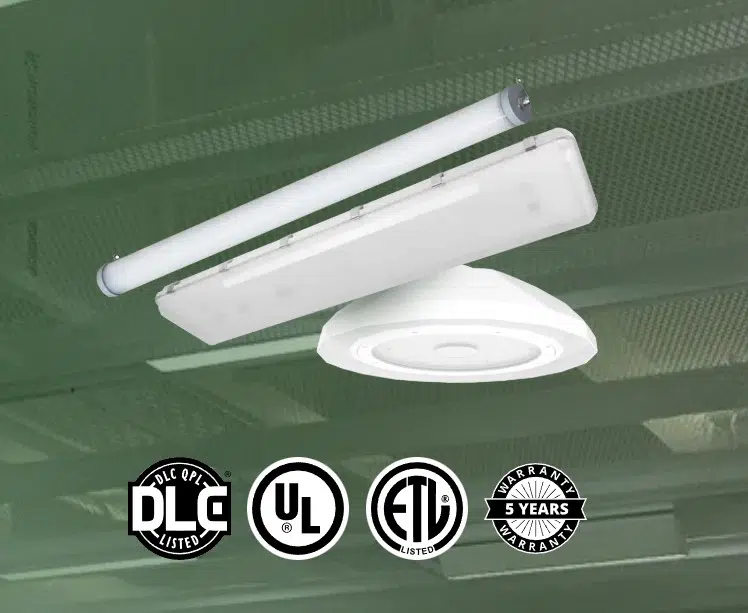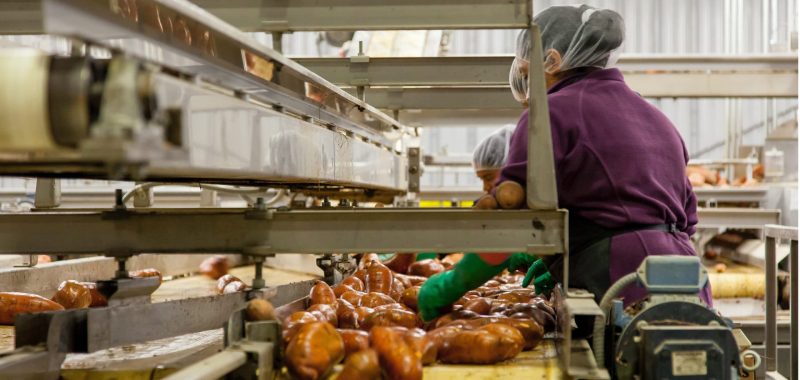Buyers Guide to NSF Rated LED Lighting
Everything in the food and beverage manufacturing industry must be tested and approved for safe use around the products we consume, even the lighting. Understanding food processing lighting requirements is critical for facility compliance. The three most important concerns revolve around preventing food contamination, bacterial growth, and product spoilage. Lighting in food processing environments must withstand exposure to dust, steam, oils, grime, water, and aggressive cleaning solutions.

Click Here to See all the Food Safe NSF Fixtures we offer
NSF Certification & LED Lighting
NSF International serves as a non-profit, independent third-party certifier for products used in food processing facilities. Their primary mission centers on maintaining high safety standards for facilities manufacturing and distributing human consumables. Through strict measures and testing methods, they ensure products comply with FDA and USDA requirements. Products earning certification may display the NSF mark. The certification process demands rigorous evaluation and testing of the product itself. Manufacturing plants undergo thorough inspection. After certification, facilities face yearly inspections to maintain NSF standards compliance.

IP Ratings and Food Safe Lighting Fixtures
IP Ratings use a two-digit system for protection classification.
- The first digit indicates protection against dust and airborne particles.
- The second digit measures liquid protection capability.
An IP00 rating offers no protection against solids or liquids. IP69 rating delivers maximum protection against both dust and water intrusion. The scale ranges from 0-6 for solid protection and 0-9 for liquid resistance. Food processing environments typically require IP65 or higher ratings. High-pressure washdown areas demand IP69 certification.

The Stringent Standards of the Food & Beverage Industry
NSF International establishes strict standards based on location conditions and food contact exposure levels. For lighting applications, NSF2 or NSF/ANSI Standard 2 governs compliance requirements. Food processing plants maintain the highest sanitation protocols and cleanliness standards while undergoing frequent inspections. NSF compliance standards evaluate facility conditions and food contact degrees, whether direct or indirect.
The Three Zones in the Food Processing Environment:
Splash Zone
Direct food contact doesn’t occur in splash zones, but cleaning liquids can splash or spill onto fixture surfaces. High-pressure hose wash-downs are common in these areas. Splash zones encompass damp process areas where hose cleaning, high-pressure purging, or decontamination procedures take place.
Food Zone
Food zones involve direct food contact during processing. This certification typically applies to equipment like worktables and cutting boards rather than lighting fixtures. While extremely strict requirements govern equipment in food zones, lighting fixtures fall outside these specific regulations. We recommend reviewing detailed requirements on the NSF website.
Non-Food Zone
Non-food zones avoid direct food contact under normal operating conditions. Light fixtures face no washdown exposure but require protection against dirt, dust, and cleaning products. These zones include food storage areas, dry and damp processing spaces, and kitchen environments. Since lighting fixtures never contact food during processing, NSF regulates only splash zones and non-food zones for lighting applications. NSF International mandates IP65 to IP69-rated fixtures for beverage and food facilities. Higher ratings provide superior water protection. IP69 fixtures withstand high-pressure, hot water washdowns, while IP65 fixtures handle wet conditions without high-pressure, high-temperature water exposure.

Complying with Food Safety Standards
Meeting these requirements becomes straightforward with proper planning. LED lighting easily complies with strict USA Department of Agriculture and FDA requirements. The FDA recommends specific light levels for food manufacturing facilities:
- Employee work areas with food equipment where safety is paramount: 54 foot candles
- Packaged food sales or consumption areas: 22 foot candles
- Dry storage and walk-in refrigeration areas at 30 inches above floor level: 12 foot candles
Poultry, dairy, and meat processors following USDA inspection regulations must meet these criteria:
- Dairy production, packaging, or cleaning locations: 30 foot candles
- Utensil packaging or manufacturing areas: 30 foot candles
- Spaces where product contamination is possible: 50 foot candles
- Food inspection areas and stations: 50 to 200 foot candles
LED Lighting Fixtures Exceed Food Industry Standards
Food processing lights must accomplish three essential functions for facility compliance:
- Easy cleaning capability reduces contamination risk while lowering maintenance costs and downtime through extended lifespans
- Adequate brightness enhances employee visibility without causing blinding glare or shadows that could lead to accidents
- Full compliance with government and industry regulations for food quality and safety
LED technology offers unique properties, making it highly suitable for various food industry operations:
- Significant energy savings and reduced operating costs
- Extended operational life, reducing replacement frequency
- High-impact robust housings for demanding environments
- Superior brightness with high-quality light output
- Minimal heat emissions prevent temperature issues
- Excellent light quality with uniform illumination and optimal distribution
- Easy retrofit installation, replacing traditional lighting one-for-one
- Multiple color temperature options for specific applications
By design, LEDs minimize damage from excess heat and degradation common with metal halide, high-pressure sodium, fluorescent, and other traditional lighting solutions. This makes LEDs particularly suitable for cold storage and freezer applications. Recent research demonstrates that LED fixtures in food facilities help preserve nutritional value post-harvest while reducing fungal infections associated with non-LED light sources. LEDs produce minimal heat while remaining unaffected by cold temperatures. We typically recommend them for food processing areas and storage environments. Their exceptional lifespan and durability help companies reduce both utility and maintenance expenses. Most of our customers see rapid ROI when replacing old HID and fluorescent systems with LED technology.
Types of LED Lights Used in Food Processing Facilities
Two main categories of NSF-rated LED fixtures serve food processing facilities:
- Small compact round fixtures with smooth, cleanable surfaces similar to LED high bay lights
- Linear strip fixtures resembling vapor-tight fixtures and linear high bays with sealed construction
Standard LED high bay lights, including UFO fixtures, lack an NSF rating despite having IP ratings. IP rating alone doesn’t satisfy NSF requirements. NSF-rated round fixtures feature smooth bodies without the heat sink grooves typical of UFO fixtures. While UFO fixtures work well for warehouse and general manufacturing applications, they don’t meet food processing standards. Similarly, linear high bays and vapor proof lights, though wet-rated and vapor-sealed, don’t qualify for NSF certification without additional compliance features.
Expert Support for Your Food Processing Facility
Our lighting specialists have decades of experience with NSF-certified fixtures and understand the unique challenges of food processing environments. We provide detailed energy savings calculations showing your exact cost reduction potential before you purchase. Our team can create custom lighting layouts for your specific facility, ensuring proper foot-candle levels in every zone while maximizing energy efficiency. You’ll receive personalized recommendations based on your facility’s actual conditions, whether you’re upgrading a dairy processing plant, meat packing facility, or beverage manufacturing operation. This expert guidance helps prevent costly mistakes and ensures your lighting investment delivers maximum ROI while maintaining full regulatory compliance.
